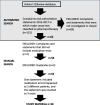Applicability of drug-related problem (DRP) classification system for classifying severe medication errors
- PMID: 37430249
- PMCID: PMC10334531
- DOI: 10.1186/s12913-023-09763-3
Applicability of drug-related problem (DRP) classification system for classifying severe medication errors
Abstract
Background: Several classification systems for medication errors (MEs) have been established over time, but none of them apply optimally for classifying severe MEs. In severe MEs, recognizing the causes of the error is essential for error prevention and risk management. Therefore, this study focuses on exploring the applicability of a cause-based DRP classification system for classifying severe MEs and their causes.
Methods: This was a retrospective document analysis study on medication-related complaints and authoritative statements investigated by the Finnish National Supervisory Authority for Welfare and Health (Valvira) in 2013-2017. The data was classified by applying a previously developed aggregated DRP classification system by Basger et al. Error setting and harm to the patient were identified using qualitative content analysis to describe the characteristics of the MEs in the data. The systems approach to human error, error prevention, and risk management was used as a theoretical framework.
Results: Fifty-eight of the complaints and authoritative statements concerned MEs, which had occurred in a wide range of social and healthcare settings. More than half of the ME cases (52%, n = 30) had caused the patient's death or severe harm. In total, 100 MEs were identified from the ME case reports. In 53% (n = 31) of the cases, more than one ME was identified, and the mean number of MEs identified was 1.7 per case. It was possible to classify all MEs according to aggregated DRP system, and only a small proportion (8%, n = 8) were classified in the category "Other," indicating that the cause of the ME could not be classified to specific cause-based category. MEs in the "Other" category included dispensing errors, documenting errors, prescribing error, and a near miss.
Conclusions: Our study provides promising preliminary results for using DRP classification system for classifying and analyzing especially severe MEs. With Basger et al.'s aggregated DRP classification system, we were able to categorize both the ME and its cause. More research is encouraged with other ME incident data from different reporting systems to confirm our results.
Keywords: Classification system; Drug-related problem; Medication error; Medication safety; Severe medication error; Taxonomy.
© 2023. The Author(s).
Conflict of interest statement
The authors declare no competing interests.
Figures



Similar articles
-
What Severe Medication Errors Reported to Health Care Supervisory Authority Tell About Medication Safety?J Patient Saf. 2021 Dec 1;17(8):e1179-e1185. doi: 10.1097/PTS.0000000000000914. J Patient Saf. 2021. PMID: 34569999 Free PMC article.
-
Medication errors in pediatric inpatients: a study based on a national mandatory reporting system.Eur J Pediatr. 2017 Dec;176(12):1697-1705. doi: 10.1007/s00431-017-3023-8. Epub 2017 Oct 1. Eur J Pediatr. 2017. PMID: 28965285
-
Descriptive analysis of medication errors reported to the Egyptian national online reporting system during six months.J Am Med Inform Assoc. 2016 Mar;23(2):366-74. doi: 10.1093/jamia/ocv096. Epub 2015 Aug 8. J Am Med Inform Assoc. 2016. PMID: 26254479 Free PMC article.
-
Medication error trends in Middle Eastern countries: A systematic review on healthcare services.J Educ Health Promot. 2021 Jun 30;10:227. doi: 10.4103/jehp.jehp_1549_20. eCollection 2021. J Educ Health Promot. 2021. PMID: 34395664 Free PMC article. Review.
-
Comprehensive Literature Review of Factors Influencing Medication Safety in Nursing Homes: Using a Systems Model.J Am Med Dir Assoc. 2017 Jun 1;18(6):470-488. doi: 10.1016/j.jamda.2016.12.069. Epub 2017 Feb 24. J Am Med Dir Assoc. 2017. PMID: 28242191 Review.
Cited by
-
Medication Errors and Error Chains Involving High-Alert Medications in a Paediatric Hospital Setting: A Qualitative Analysis of Self-Reported Medication Safety Incidents.Drugs Real World Outcomes. 2025 Mar;12(1):45-61. doi: 10.1007/s40801-024-00469-4. Epub 2024 Dec 11. Drugs Real World Outcomes. 2025. PMID: 39661246 Free PMC article.
-
Patient safety reporting and learning system of Catalonia (SNiSP Cat): a health policy initiative to enhance culture, leadership and professional engagement.BMJ Open Qual. 2024 Aug 7;13(3):e002610. doi: 10.1136/bmjoq-2023-002610. BMJ Open Qual. 2024. PMID: 39117393 Free PMC article.
References
-
- Committee on Identifying and Preventing Medication Errors. Aspden P, Wolcott J, Bootman JL, Cronenwett LR (eds). Preventing medication errors: quality chasm series. Washington, DC: National Academies Press; 2006.
-
- World Health Organization (WHO). The third WHO Global Patient Safety Challenge: Medication Without Harm. https://www.who.int/publications/i/item/WHO-HIS-SDS-2017.6. Accessed 6 March 2023.
-
- National Coordinating Council for Medication Error Reporting and Prevention (NCCMERP). What is a Medication Error? https://www.nccmerp.org/about-medication-errors. Accessed 6 March 2023.
-
- Institute for Safe Medication Practices. Error Reporting and Analysis. https://www.ismp.org/error-reporting-programs. Accessed 6 March 2023.
MeSH terms
LinkOut - more resources
Full Text Sources
Miscellaneous

